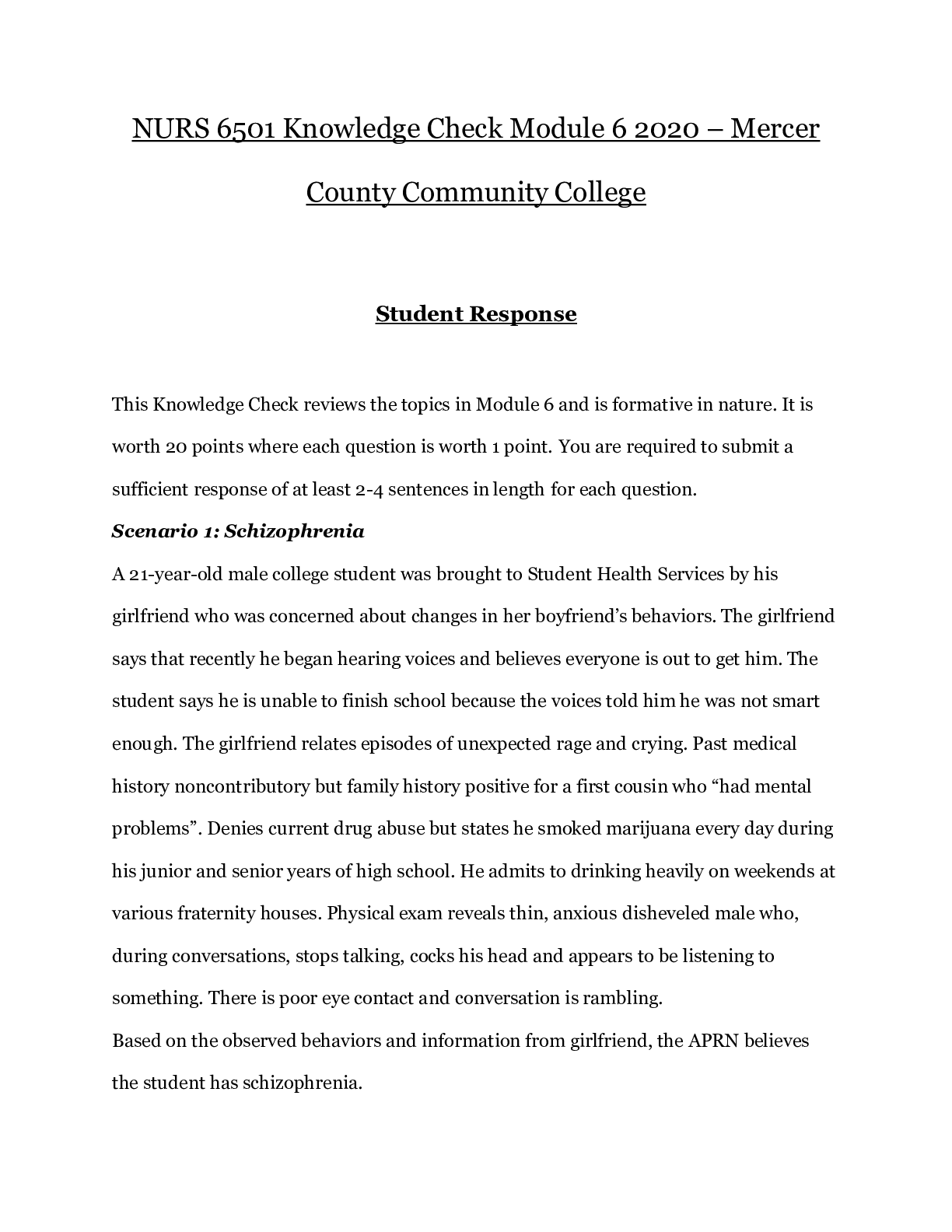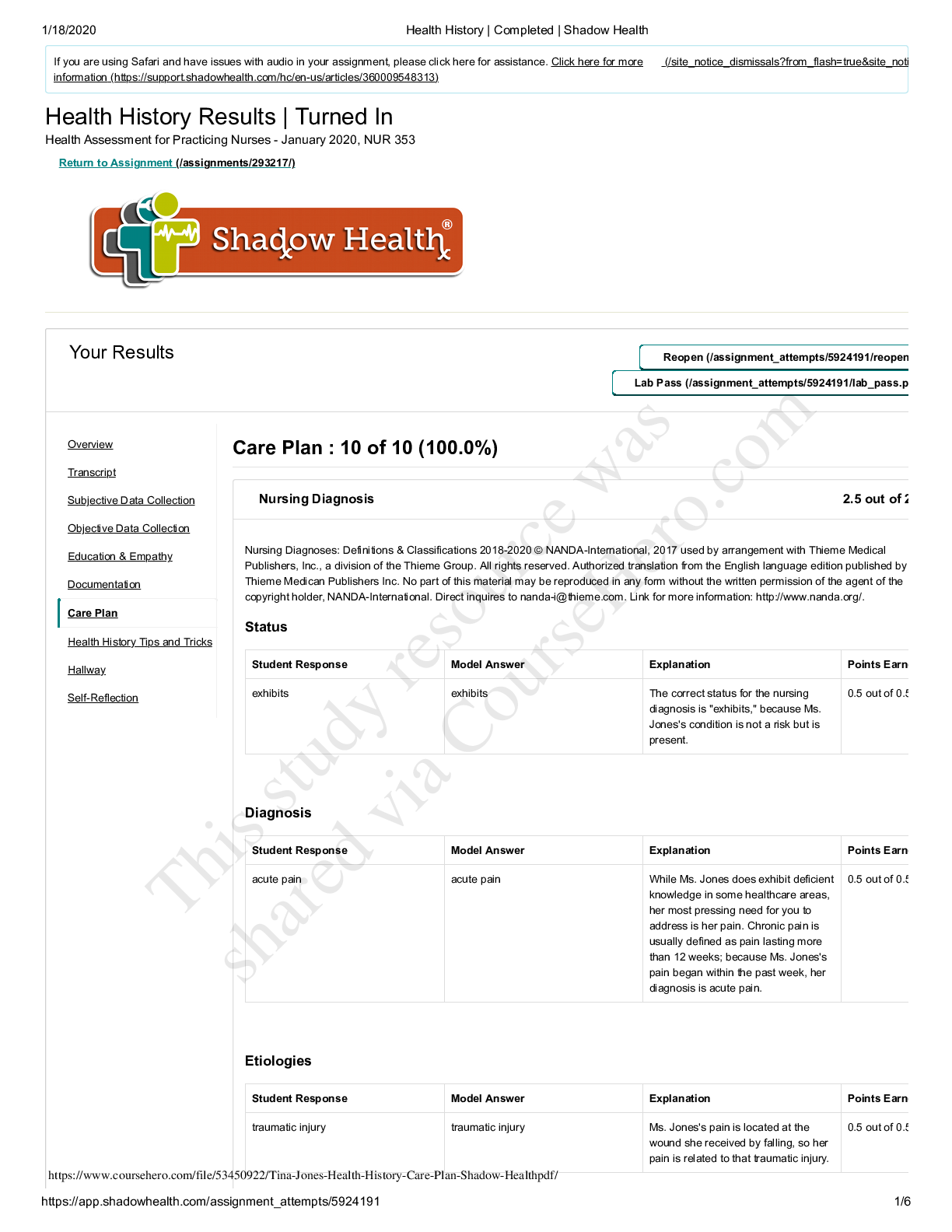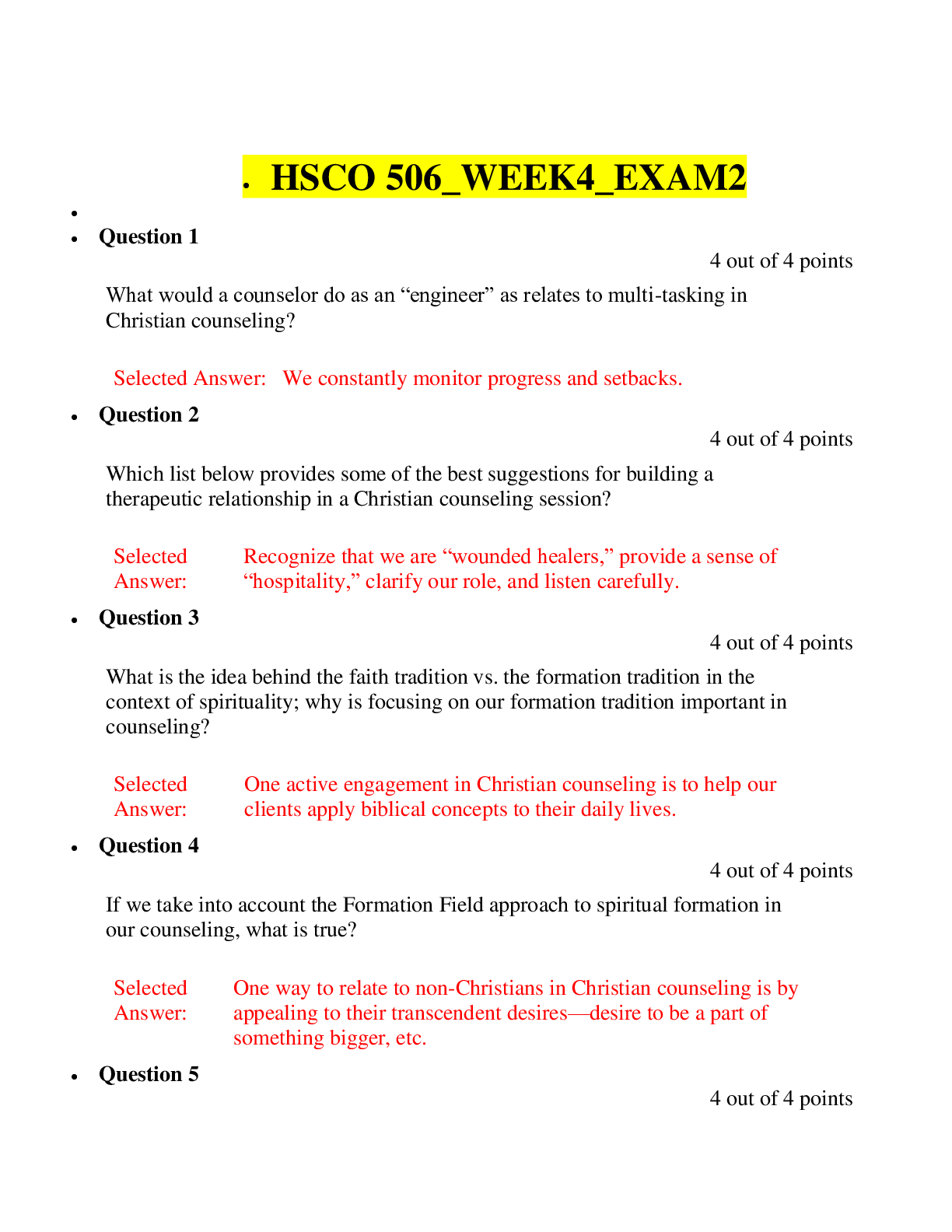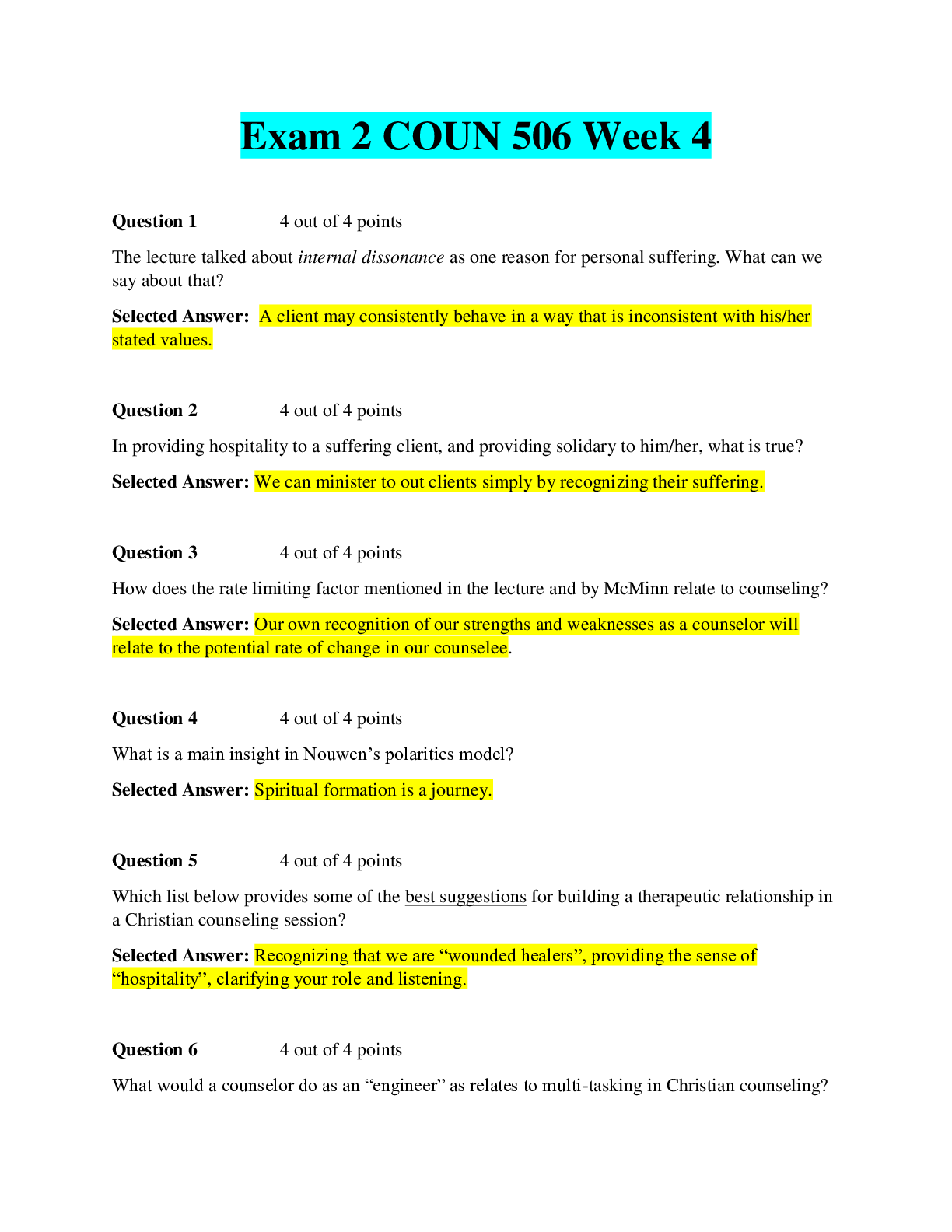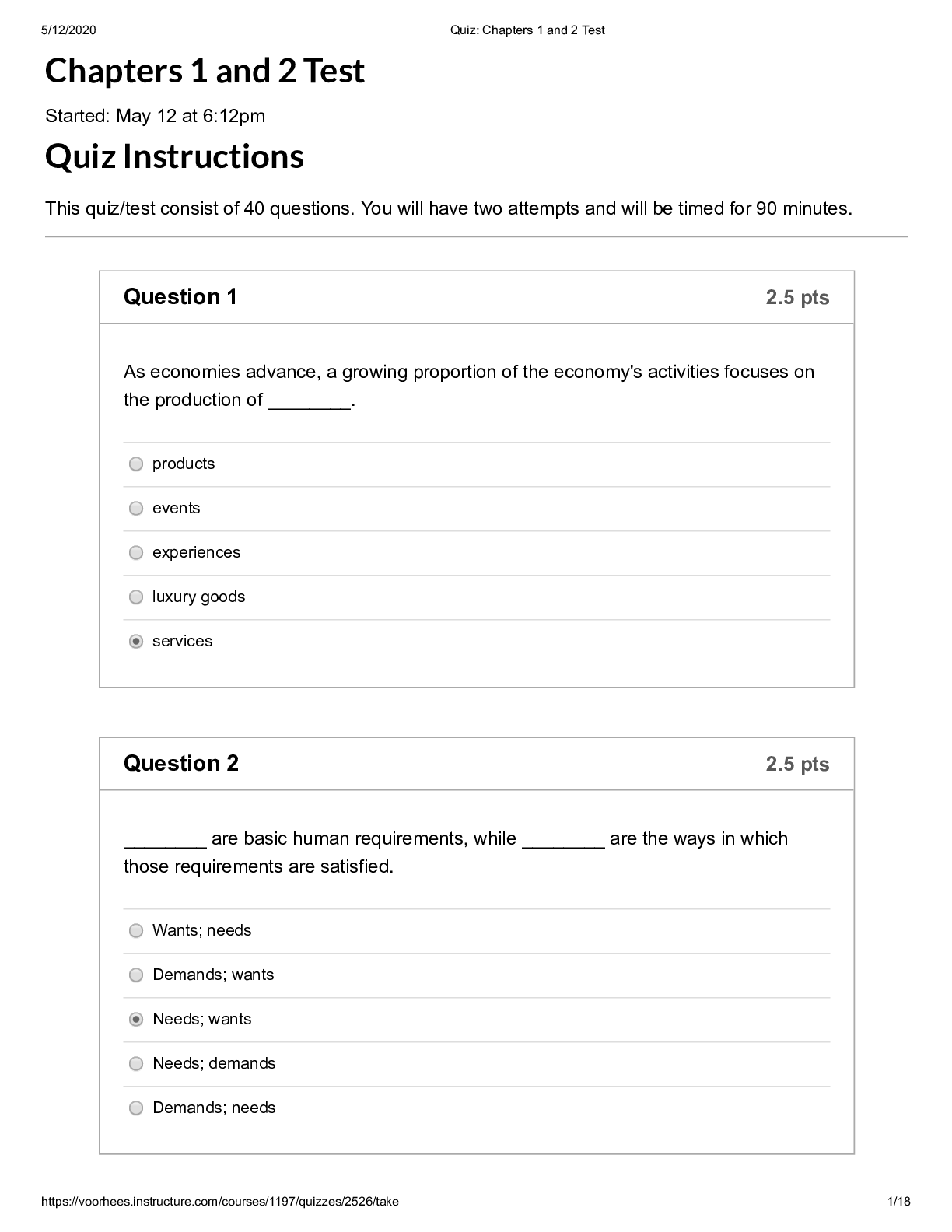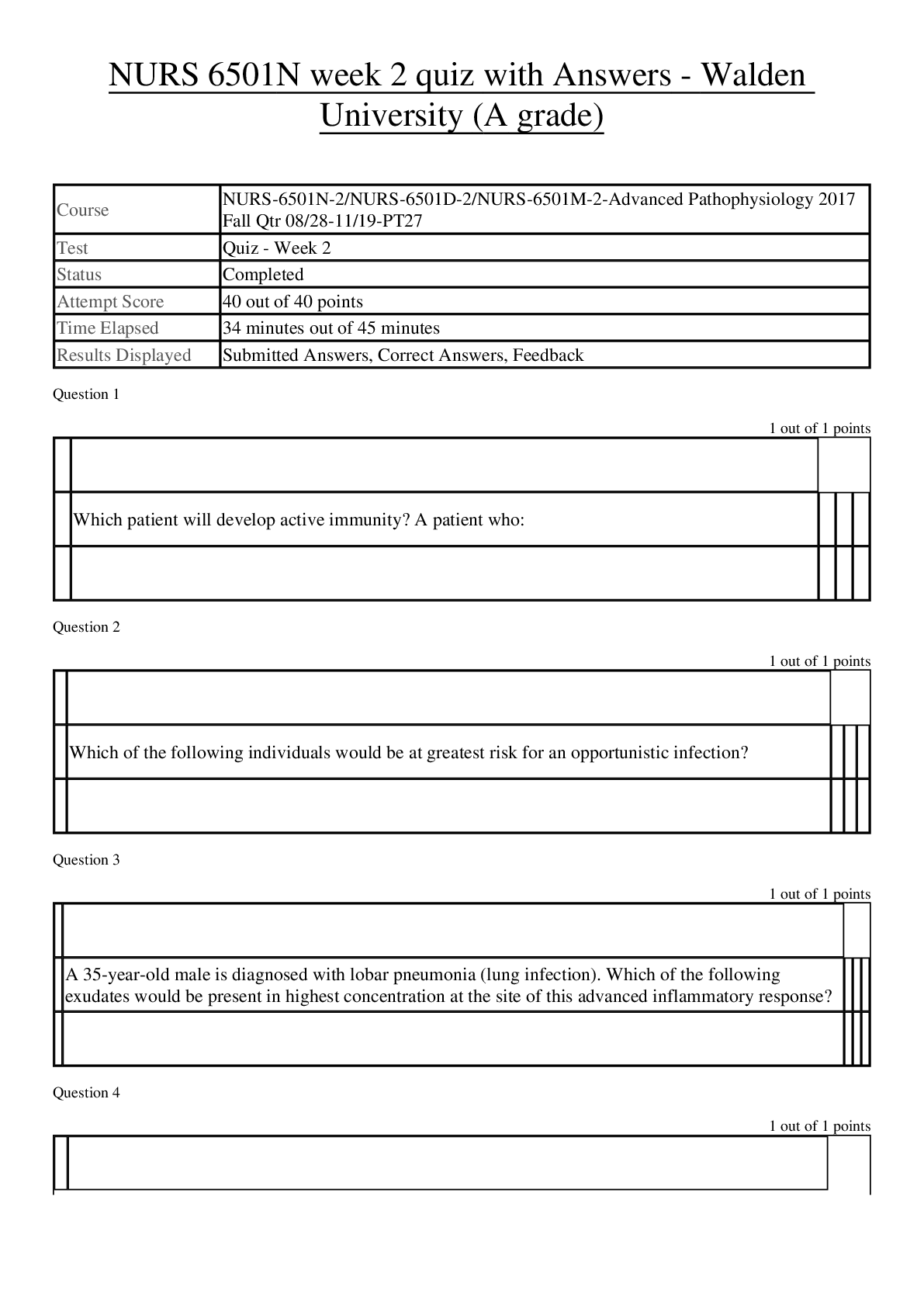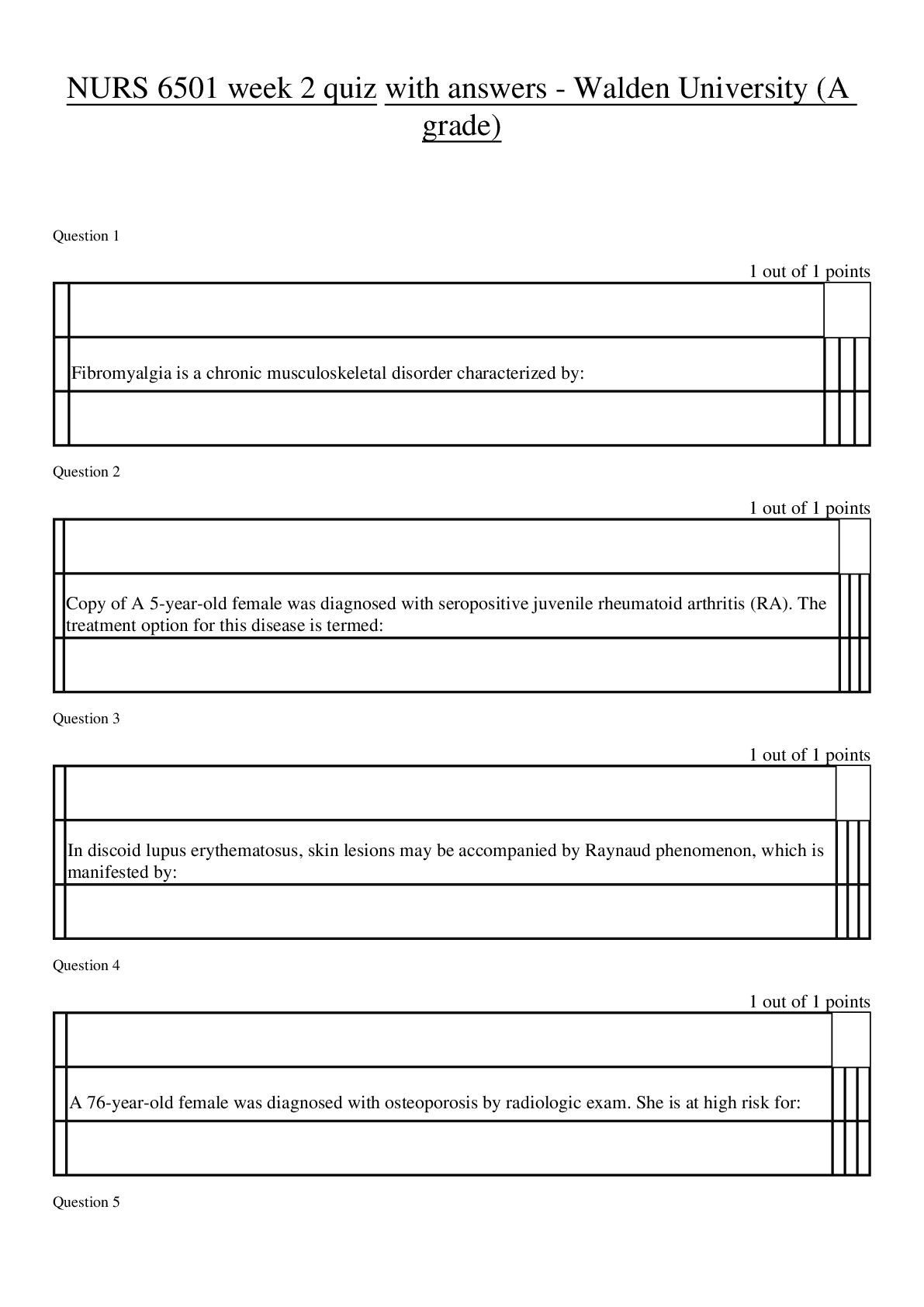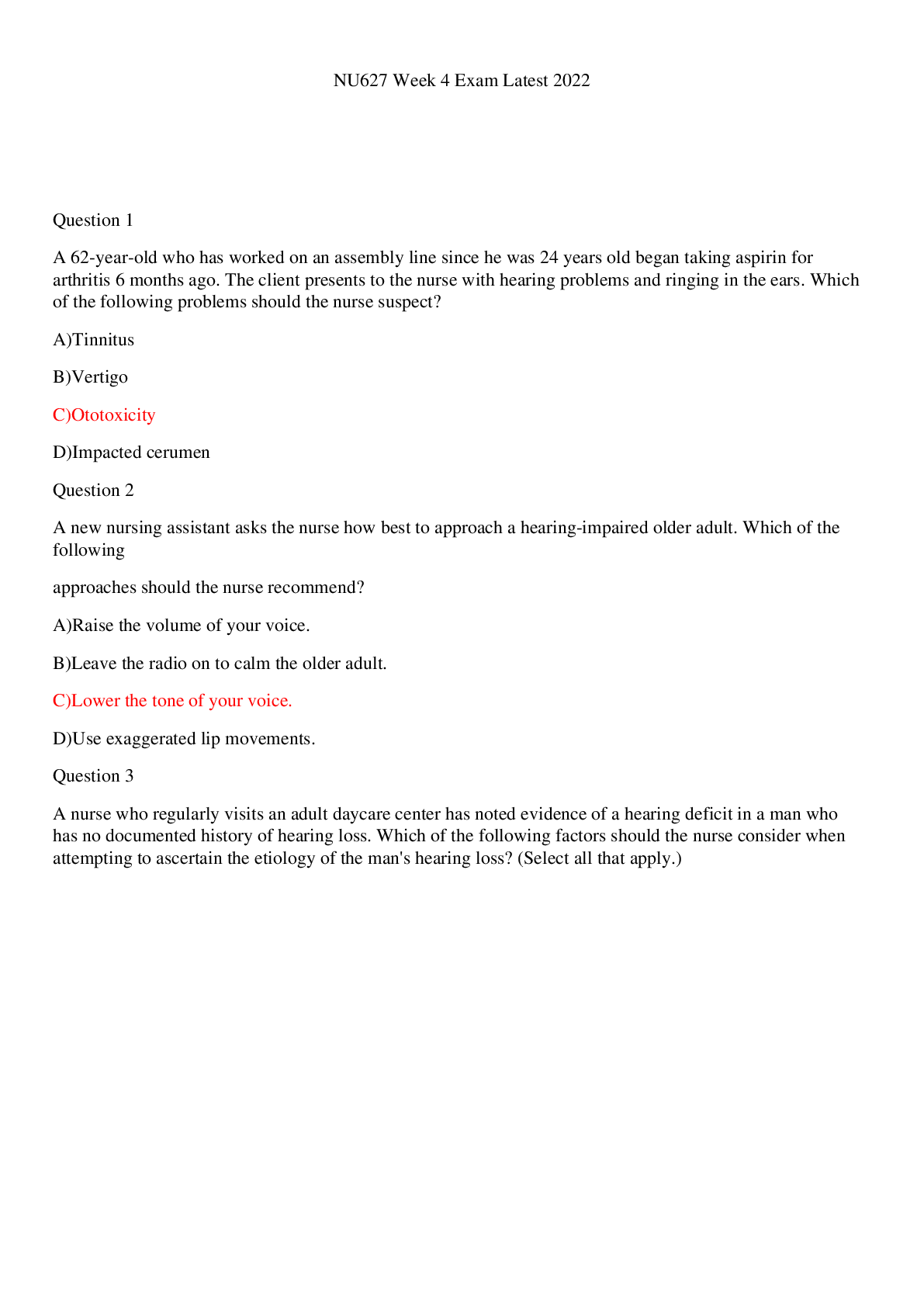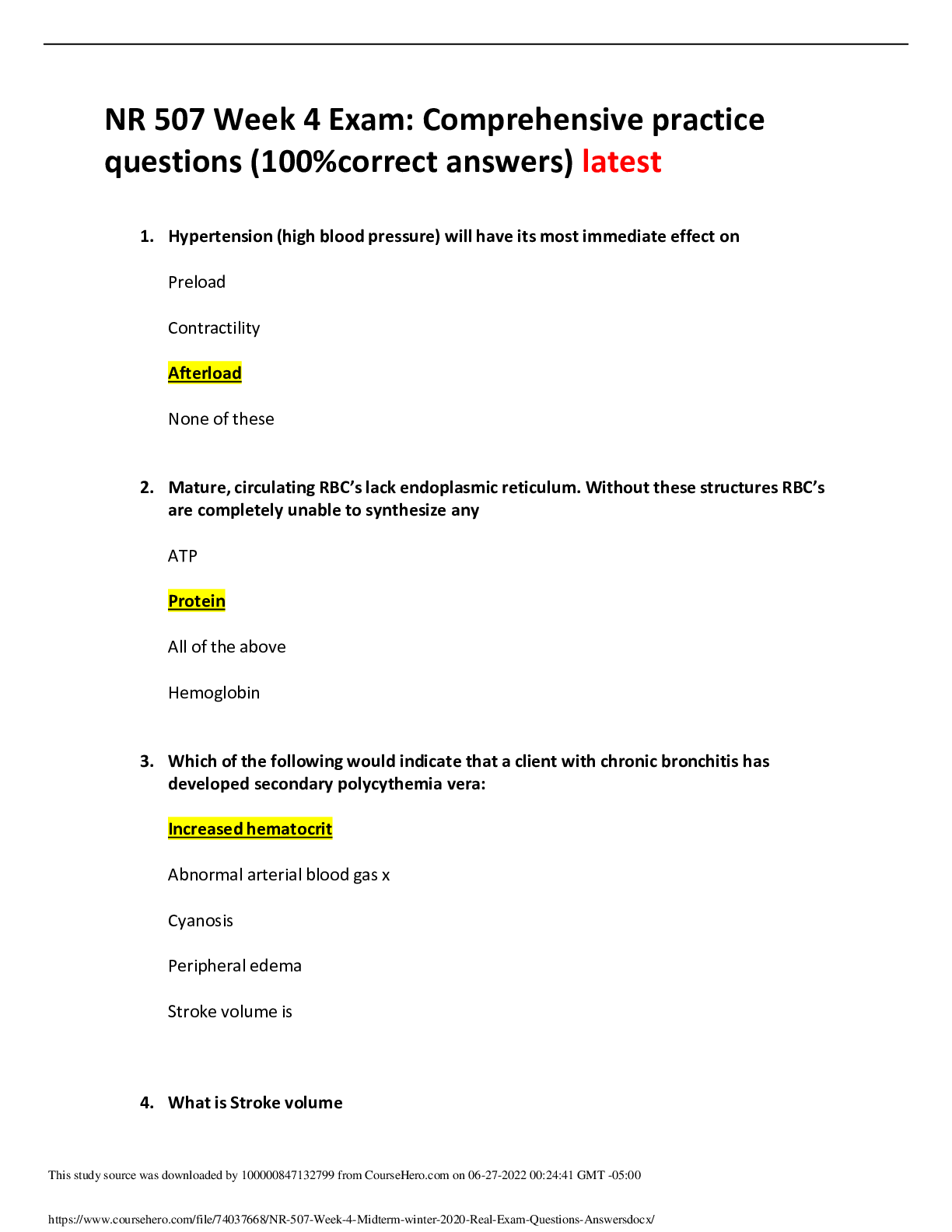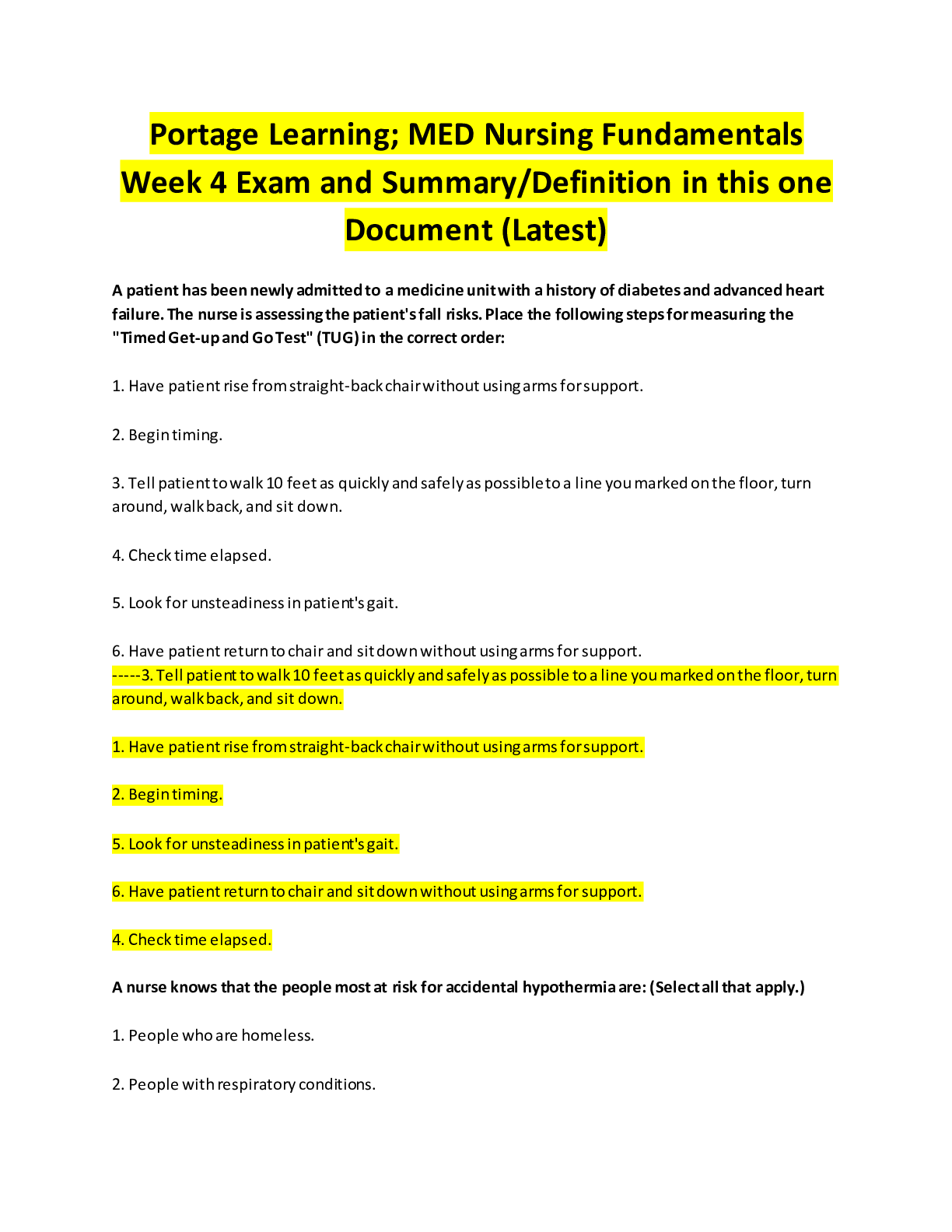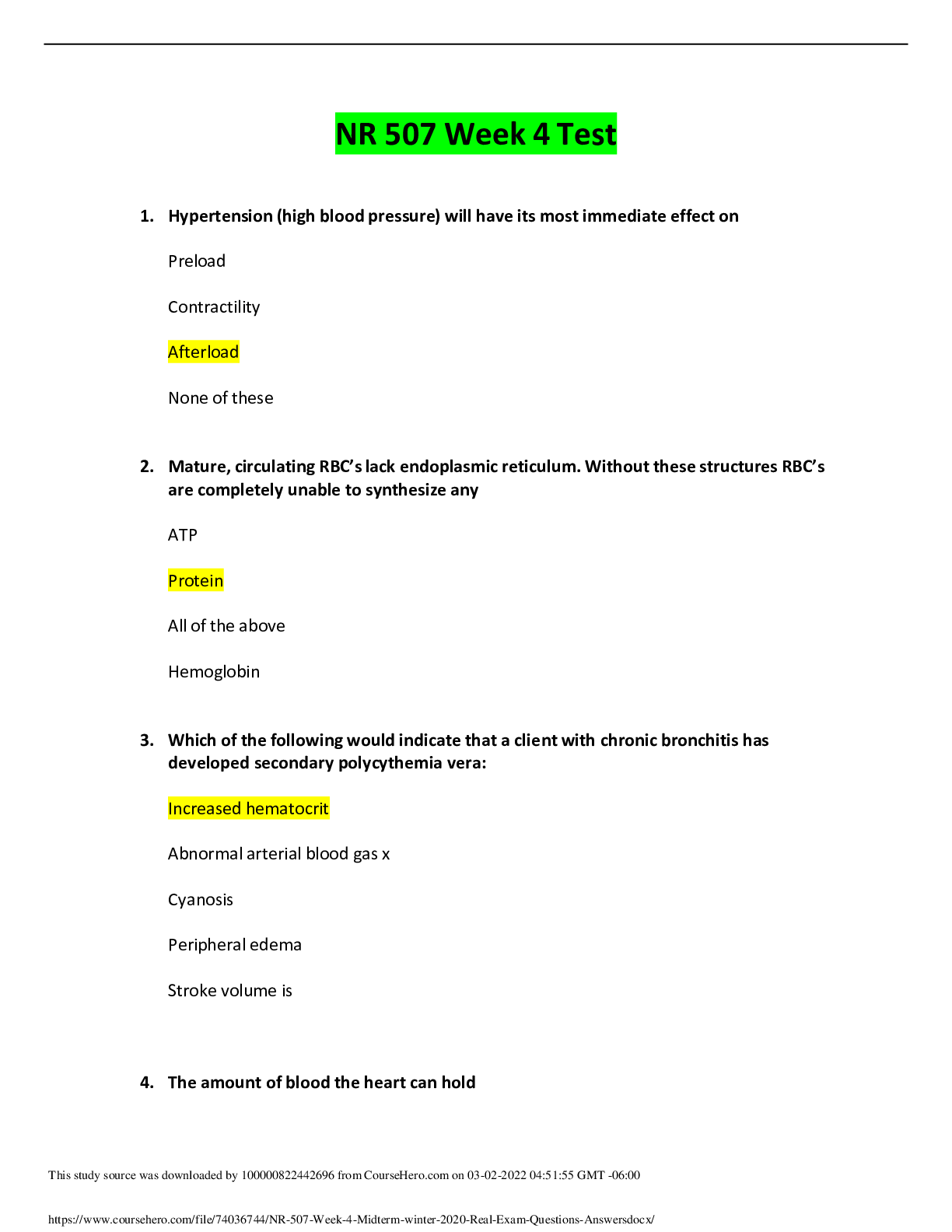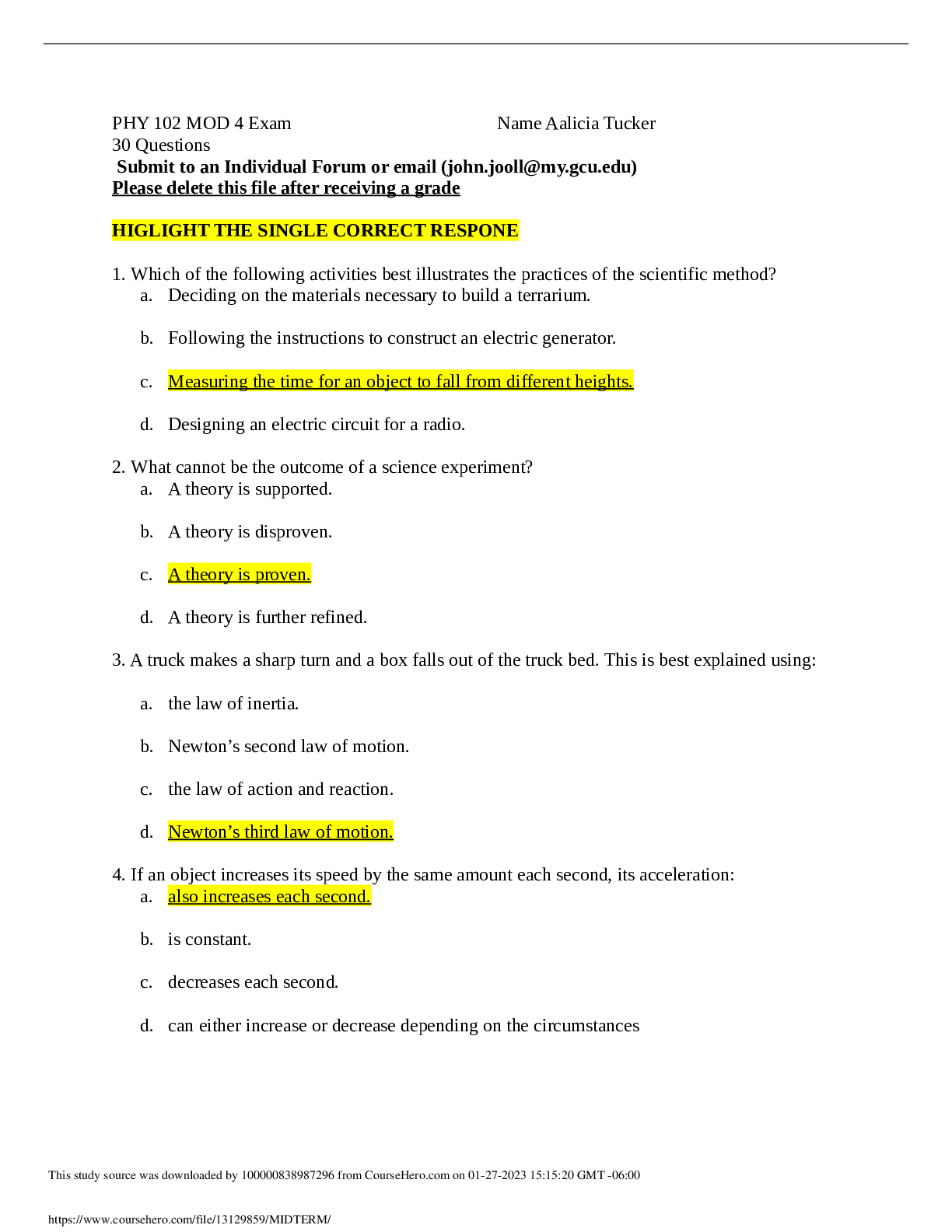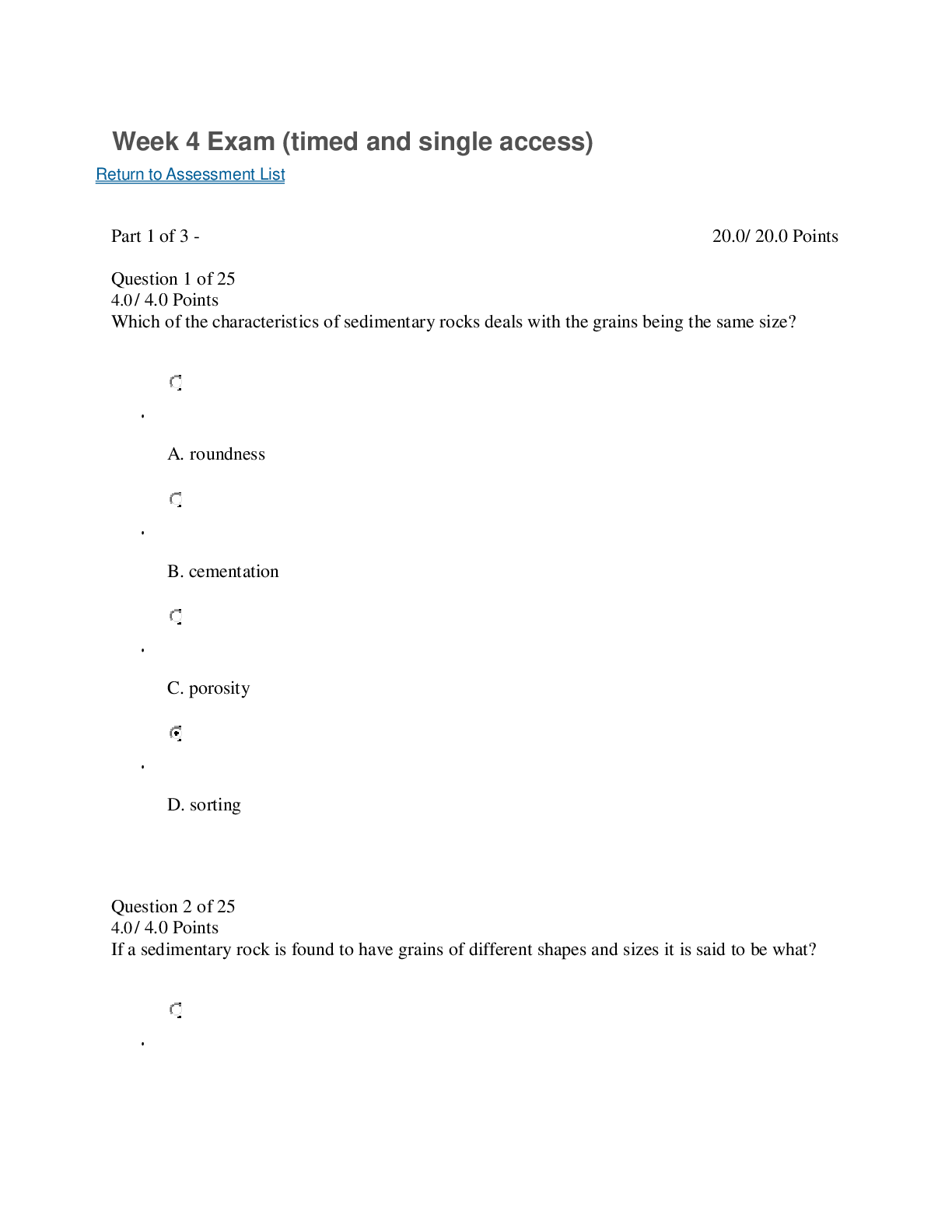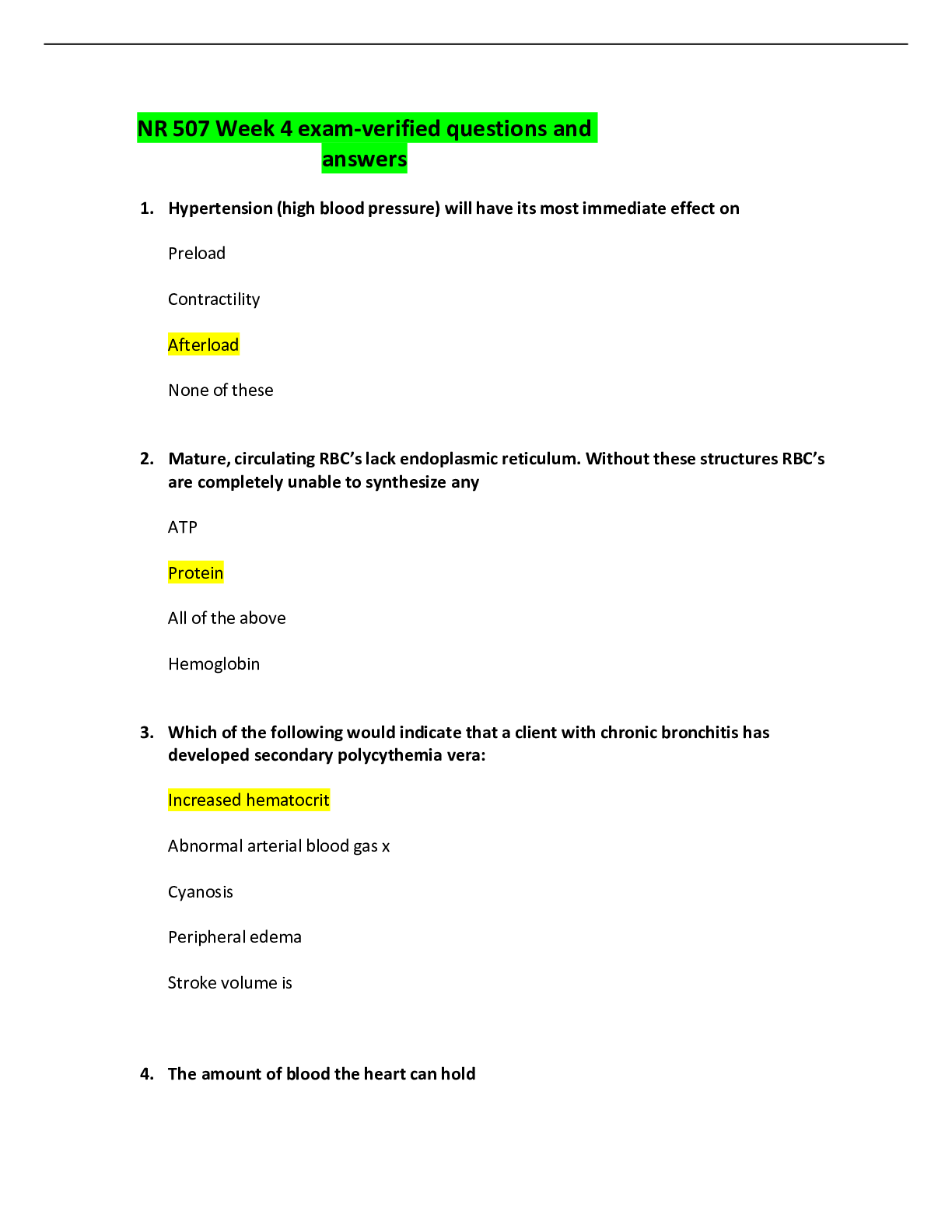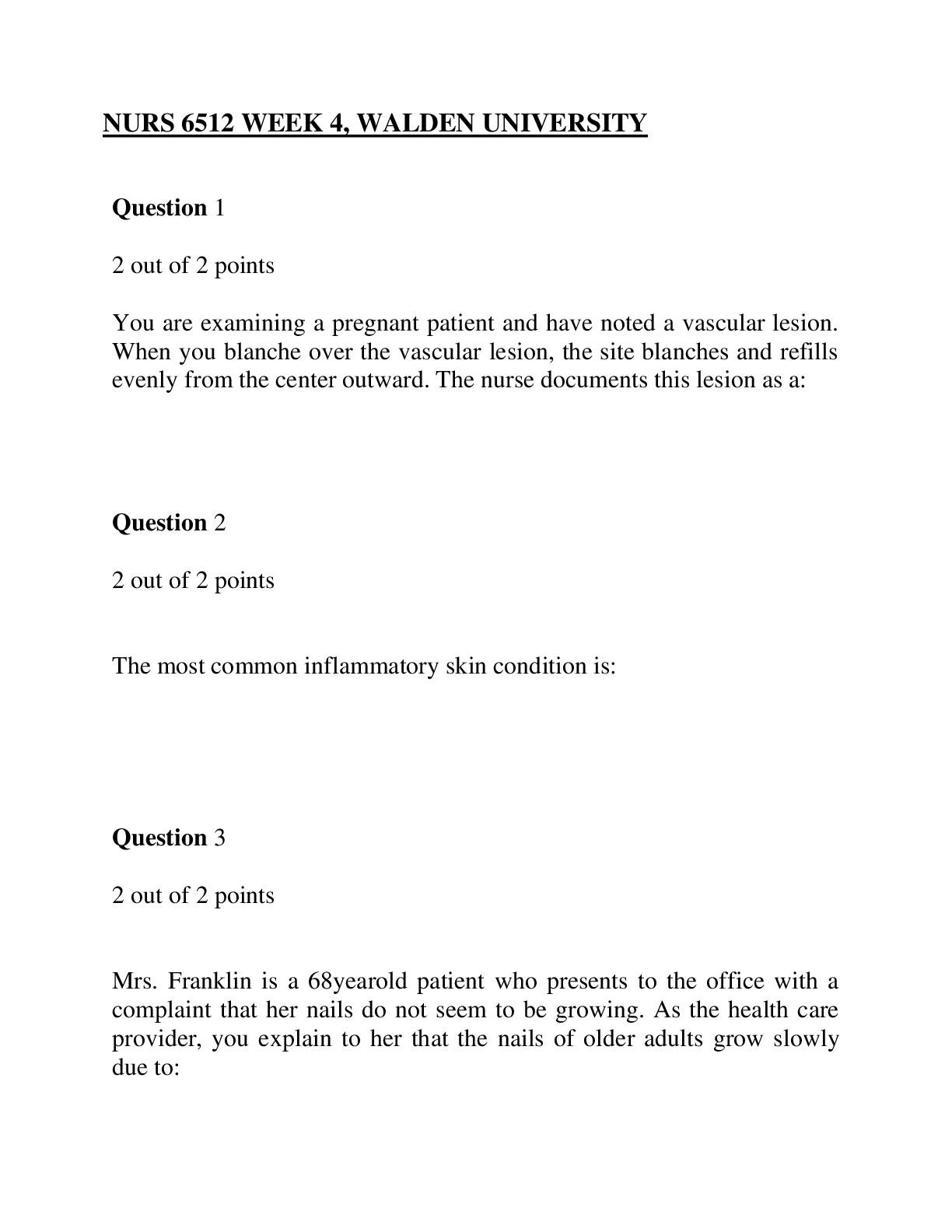*NURSING > EXAM > NR 351 Week 4 Exam with answers - Wagner College (A grade) | NR351 Week 4 Exam with answers - A grad (All)
NR 351 Week 4 Exam with answers - Wagner College (A grade) | NR351 Week 4 Exam with answers - A grade
Document Content and Description Below
NR 351 Week 4 Exam with answers - Wagner College (A grade) NR 351 Exam 4 Chapter 30 Hygiene- measure of personal cleanliness Factors affecting it: culture, economic class, spiritual practice,... health state Assessing the Skin • Head-to-toe sequence • Compare bilateral for symmetry • What to consider? • Cleanliness, color, temperature, turgor, moisture, sensation, vascularity, evidence of lesions (ABCDE) Assessment of Oral Cavity • Lips- color/moisture • Buccal mucosa- color/nodules/bleeding • Color and surface of gums • Teeth- loose/missing/dentures (if they fit well) • Hard & soft palate- intact/patches • Oropharynx- movement of uvula (grading of tonsils) • Halitosis/bad taste in mouth • BOHSE- brief oral health status exam • Observe for oral problems- dental caries (cavities), gingivitis, periodontal disease • Mouth breathers/comatose patients Oral Hygiene • Moistening/cleaning the mouth • Caring for dentures- remove when sleeping; wear gloves when cleaning • Using mouthwashes- for children must contain fluoride Early Morning Care • Assist patient with toileting • Provide comfort measures • Wash face and hands • Provide mouth care Morning Care (AM care) *after breakfast unless patient wants it done first • Toileting • Oral care • Bathing • Back massage/ special skin measures • Hair care/cosmetics/dressing • Position for comfort • Refresh or change bed linens/tidying up bedside Afternoon Care (PM care) *ensure patients comfort after lunch • Offer assistance with toileting, hand washing, oral care • Straighten bed linens • Help patient with mobility to reposition self Hours of Sleep Care (HS care) *before patient goes to bed • Offer assistance with toileting, washing and oral care • Offer back massage • Change any soiled linens • Position patient comfortably • Ensure call light or any other objects are in reach As Needed Care (PRN care) • Offer individual hygiene as needed • Change clothing and bed linens to diaphoretic patients • Provide oral care every 2 hours as needed Back Massages • Act as body conditioners to relieve tension and promote relaxation • Also allows nurse to observe skin for signs of breakdown • Improves circulation and sleep quality Bathing • Same as back massages • Musculoskeletal exercise • Helps improve self image • Strengthens nurse-patient relationship- give patient a level of participation (independence) Bed Bath • Provide articles needed on bed table/ provide privacy • Remove top linens and replace with bath blanket • Eye care • Clean from inner to outer with warm compress • Use artificial tear solution or saline every 4 hours if no blink reflex • Care for eyeglasses, contact lens, artificial eye • Ear and nose care • Wash external ear with washcloth; check hearing aid battery (whistling sound on HIGH) • Have patient blow nose; remove crust around nose with warm compress • Hair care • Groom and shampoo hair; care for beards and mustaches; remove unwanted hair • Treat any lice (pediculosis) and ticks • Nail and foot care • Assess color, shape, intactness and cleanliness • Massage feet, provide diabetic foot care • Avoid knee high socks/crossing knees; prop feet up several x a day • Perineal and vaginal care • Perform assessment of genitalia and perform care • Cleanse vaginal area with plain soap and water (pubic anal) • Sitz bath- soak perineal and anal areas • Piercings • Aftercare; avoid alcohol, peroxide, ointments • Oral piercings- avoid tobacco, use alcohol-free mouthwash Bedside Safety (medical asepsis) • Bed in its lowest position; safe for patient • Make sure bed controls are functioning (call light and other electrical equipment) • Walk space is uncluttered; side rails are raised if indicated; wheels locked Chapter 31 Functions of Skin (first line of defense) • Protection; body temperature regulation; vitamin D production; absorption • Epidermis, dermis, subcutaneous • Children younger than 2 thinner and weaker skin; mucous membranes are easily injured and subject to infection • Older children increasingly resistant to injury and infection • Aging people skin loses elasticity, folds and sags; thin, dry and wrinkled; circulation and collagen formation are impaired • Nourished and hydrated body cells are resistant to injury; adequate circulation is necessary • Very thin and very obese people are more susceptible to skin injury • Excessive perspiration predisposes skin to breakdown • Jaundice causes yellowish, itchy skin • Eczema and psoriasis may cause lesions that require special care Types of Wounds • Intentional/unintentional; open/closed; acute/chronic; 4 stages of ulcers • Primary- edges match up • Secondary- burns/stabbing; uneven edges • Tertiary- delayed primary closure; left open before fully closed • Wound Healing: • Hand hygiene; adequate blood supply; free of foreign material Phases of Wound Healing • Hemostasis • Occurs immediately after injury; involved blood vessels constrict and clotting begins • Exudate is formed, causing swelling and pain; results in heat and redness • Platelets stimulate other cells to migrate to injury to help heal • Inflammatory (sometimes includes hemostatis) • Lasts 4-6 days • WBC move to the wound; macrophages enter wound • They ingest debris and attract fibroblasts to fill wound • Patient has body response (fever, increase in wbc) • Proliferation • Begins within 2-3 days of injury; may last 2-3 weeks • New tissue is built to fill wound space from fibroblasts • Capillaries and thin layer of epithelial cells form across wound • Granulation tissue forms foundation for scar tissue • Secondary wounds take longer in this stage • Maturation • Final stage of healing; begins 3 weeks-6 months after injury • Collagen is remodeled; new collagen tissue is deposited • Scar becomes flat, white line Factors Affecting Wound Healing (causing delay) • Desiccation: (dehydration) crust • Maceration: (over hydration) occurs with incontinence • Trauma- repeated injury • Edema / Infection (bacteria in wound) • Necrosis: death of tissue • Presence of biofilm: thick grouping of microorganisms - - - - - -- -- - - - - - - - - - - - - - - - - Gate Control Theory of Pain • Recognizes relationship between pain and emotions • Gating mechanism determines the impulses that reach the brain Perception of Pain • Pain threshold • Modulation of pain- neuromodulators; endorphins, dynorphins, enkephalins (ways to inhibit effects of pain) • Physiologic- involuntary; ex/ increase in blood pressure, pupils dilated • Behavioral- “guarding” • Affective- psychological; ex/ anxiety, fatigue, anorexia Basic Methods of Assessing Pain (2011) • Patient self report; report of family members • Nonverbal behaviors: restlessness, grimacing, crying, clenching fists, guarding • Physiologic: increased blood pressure and pulse Pain Assessment Tools • Wong Baker FACES children • Beyer oucher pain scale 1-10 • CRIES pain scale newborns • FLACC pain scale • Faces, legs activity, cry, consolability • 2 months to 7 year olds; unresponsive elderly Pharmacologic Pain Relief • Start simple analgesic administration (PRN) • Nonopioid analgesics- Tylenol NSAIDS • Opioids or narcotic analgesics- controlled substances • Adjuvant dugs- nerve pain ex/ diabetics medicine The WHO 3-Step Analgesic Ladder- explains whether to give pain medications and what type to give Numeric Sedation Scale (NAN- no action necessary) S: sleep, easy to arouse; NAN 1: awake and alert, NAN 2: occasionally drowsy, but easy to arouse, NAN 3: frequently drowsy, drifts off to sleep during conversation; reduce dosage 4: somnolent with minimal or no response to stimuli; discontinue opioid, consider use of naloxone (NARCAN) [Show More]
Last updated: 1 year ago
Preview 1 out of 13 pages
.png)
Reviews( 0 )
Document information
Connected school, study & course
About the document
Uploaded On
Jan 18, 2021
Number of pages
13
Written in
Additional information
This document has been written for:
Uploaded
Jan 18, 2021
Downloads
0
Views
46
.png)

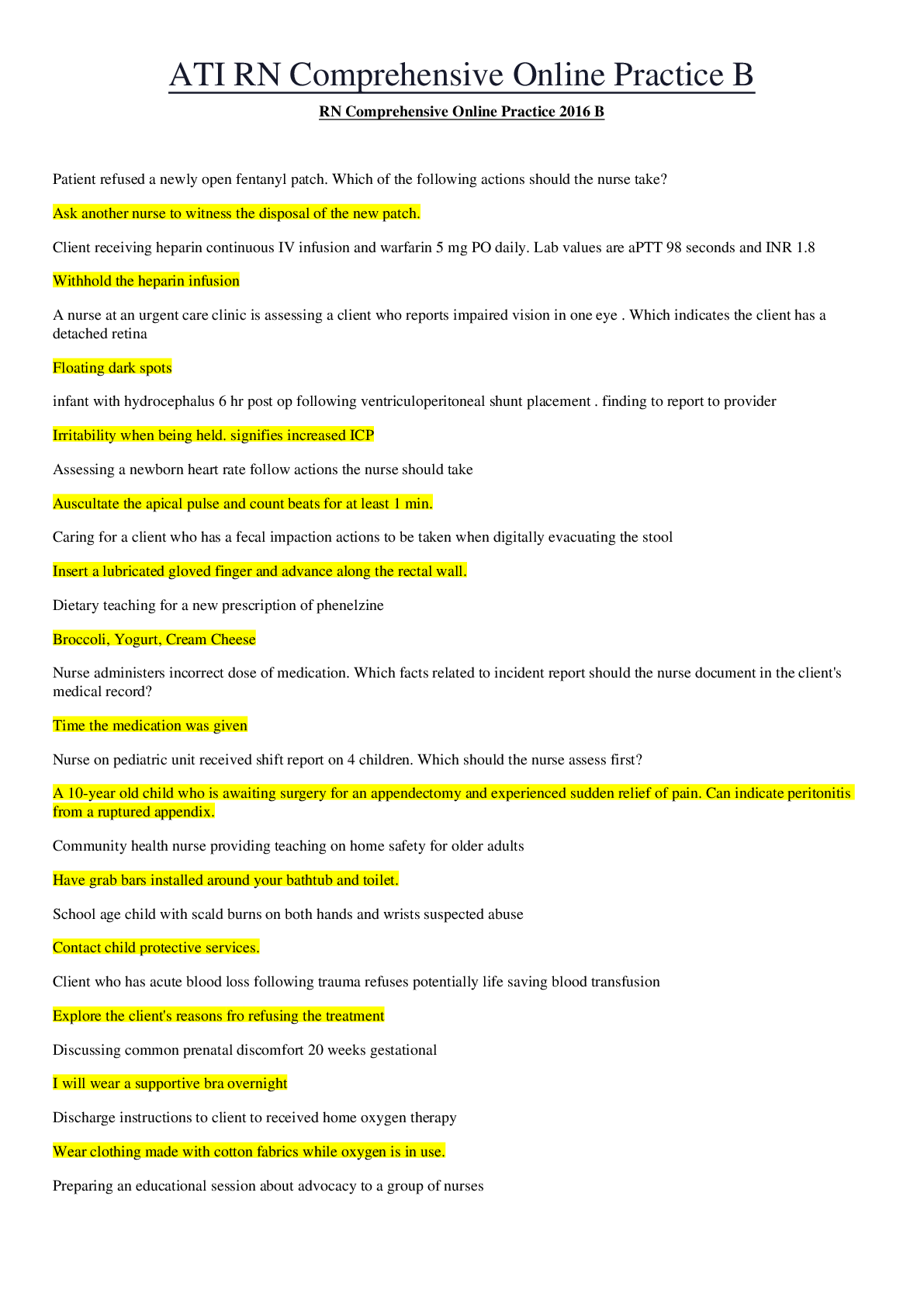
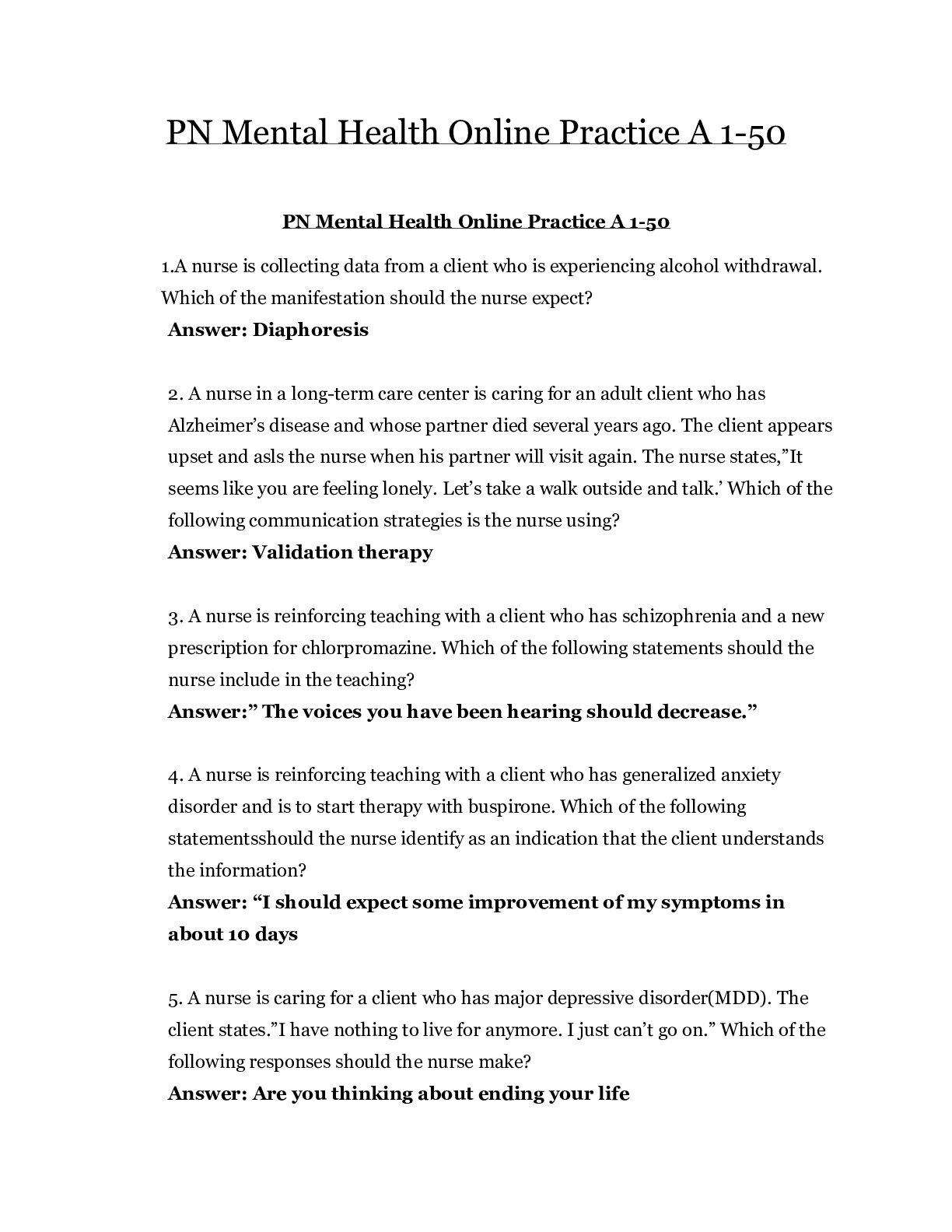
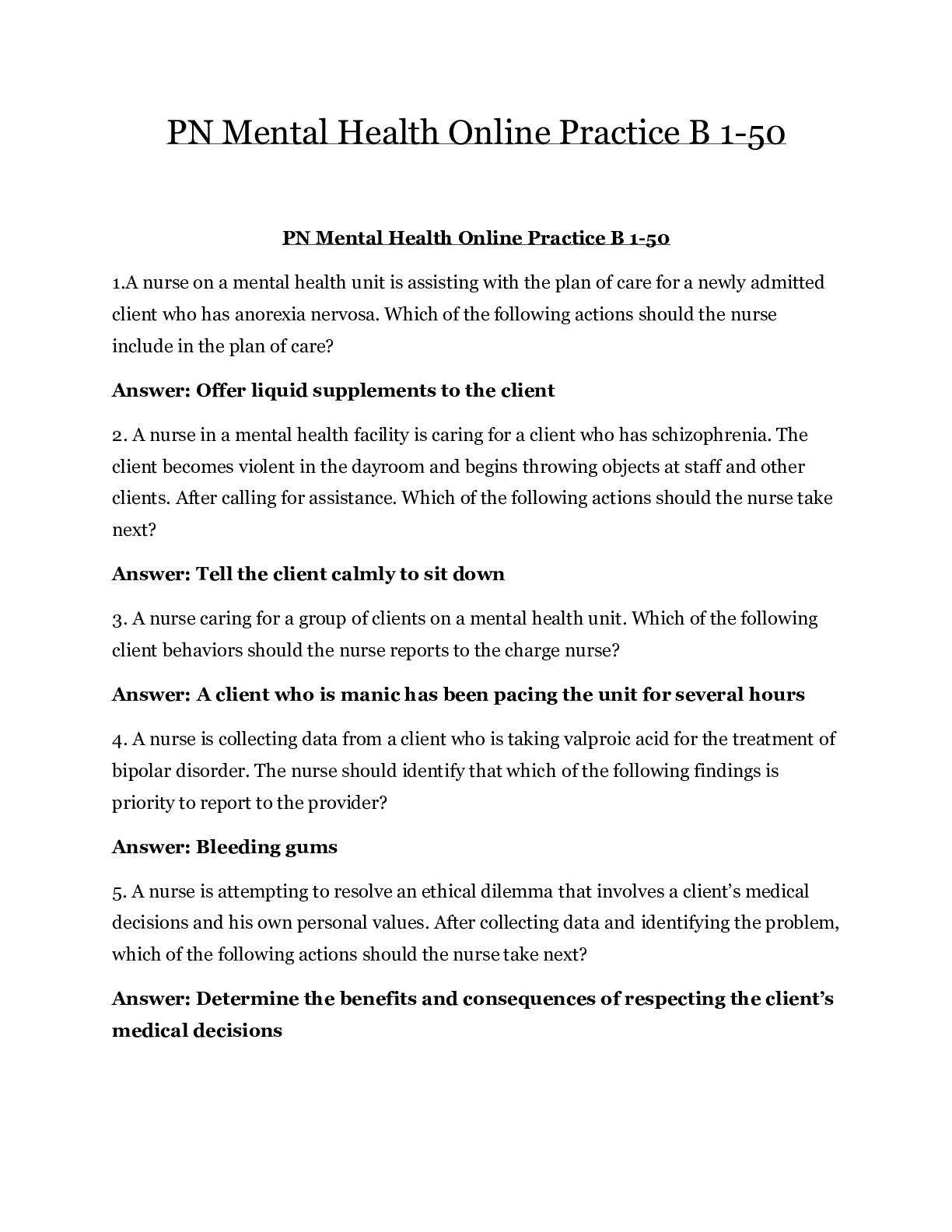
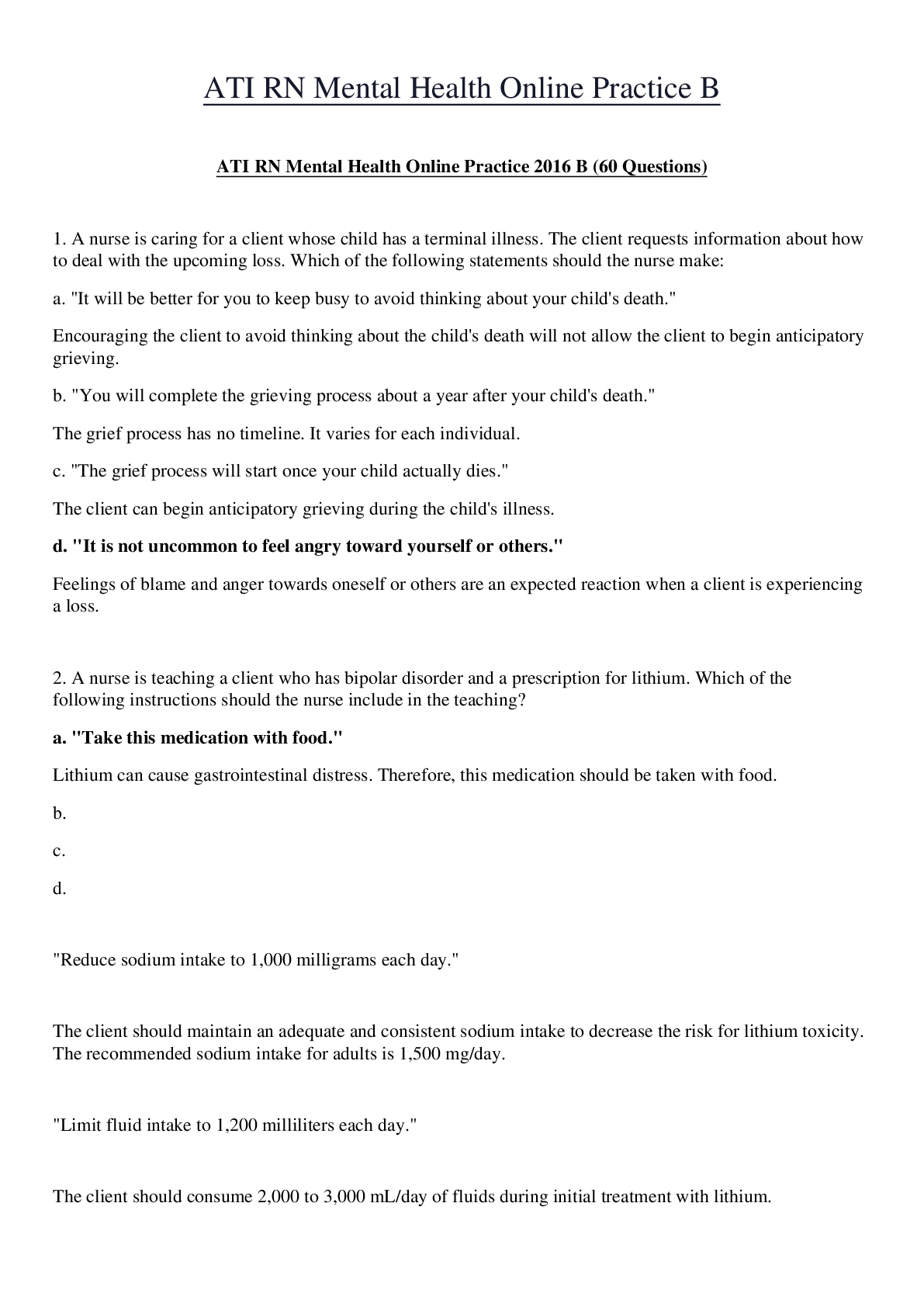

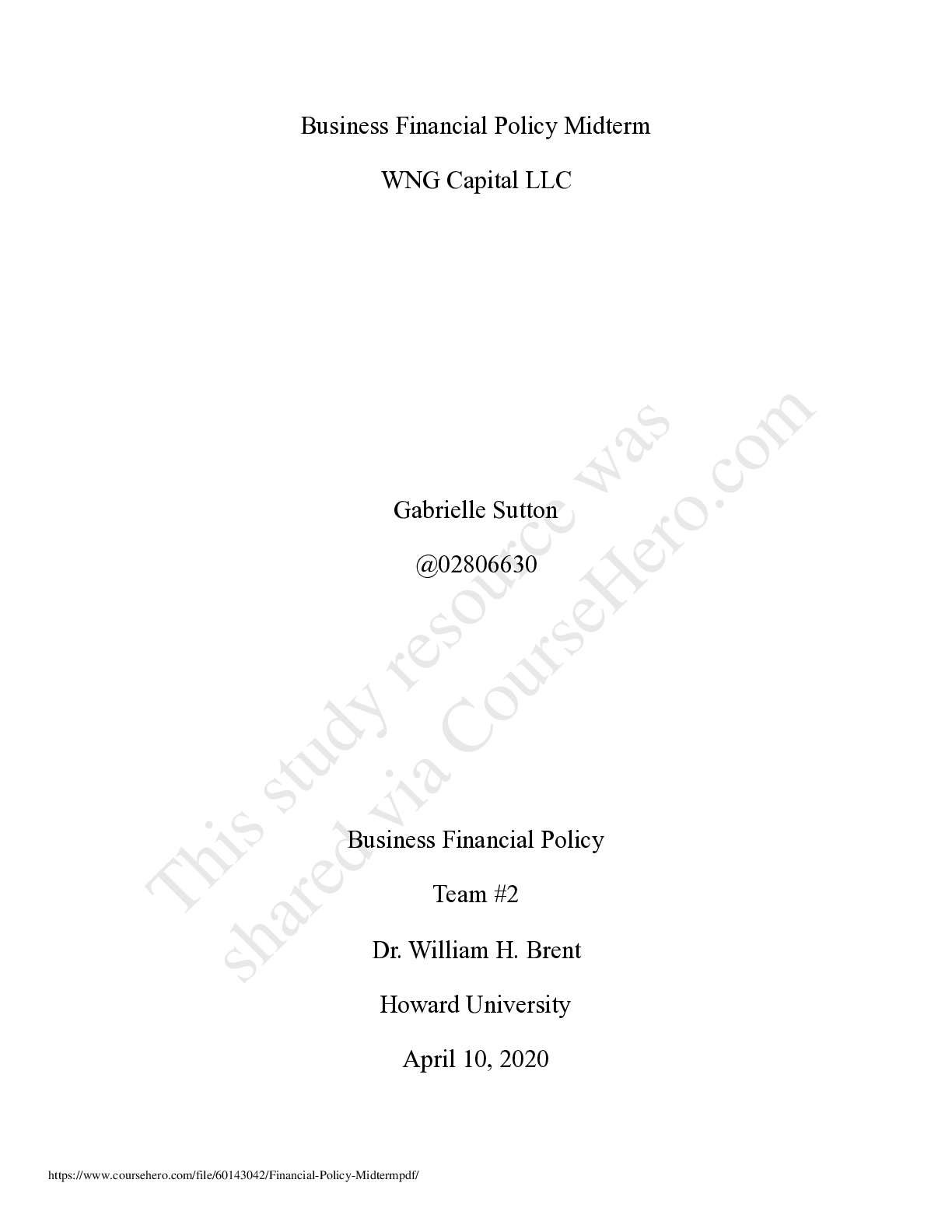
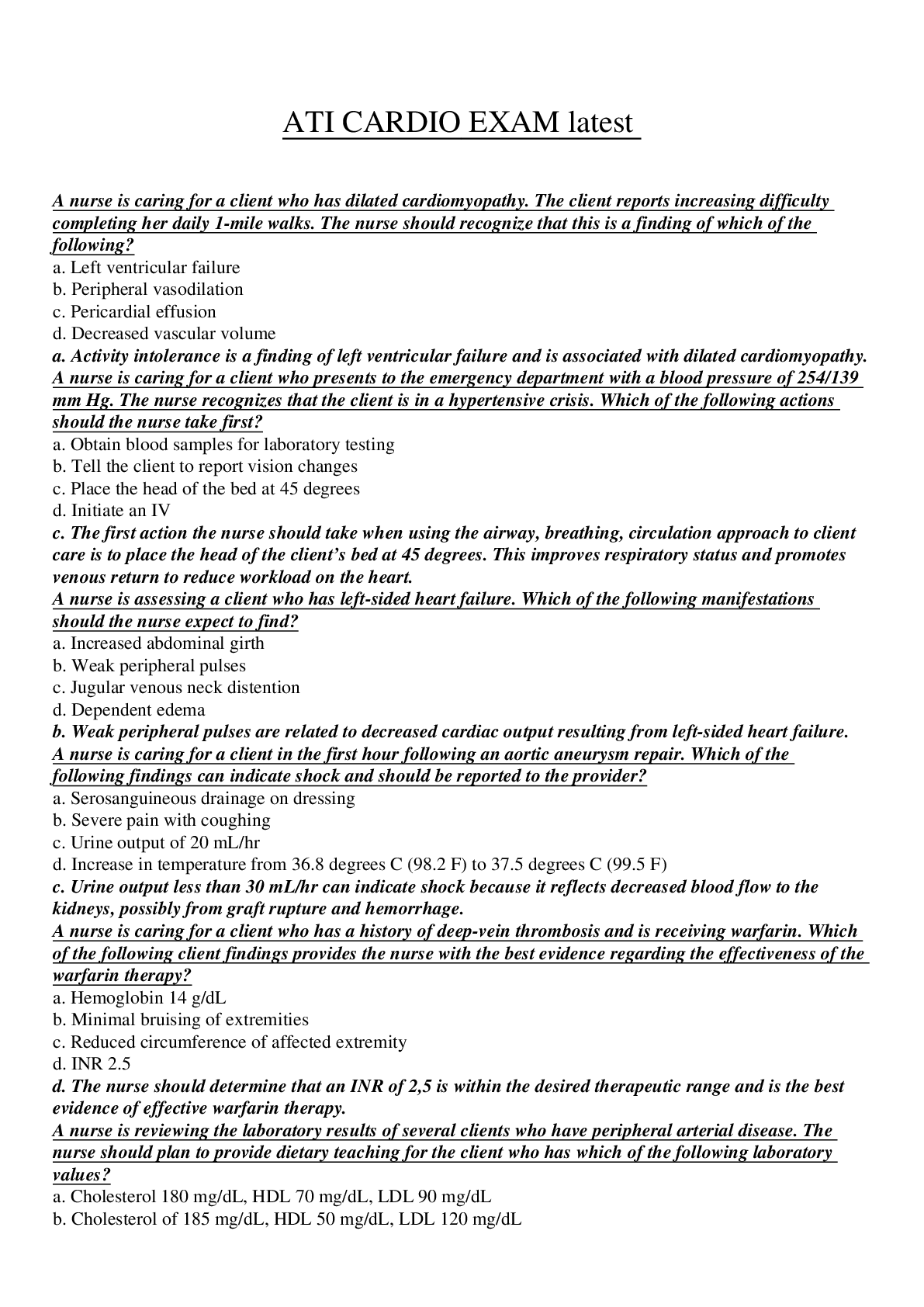
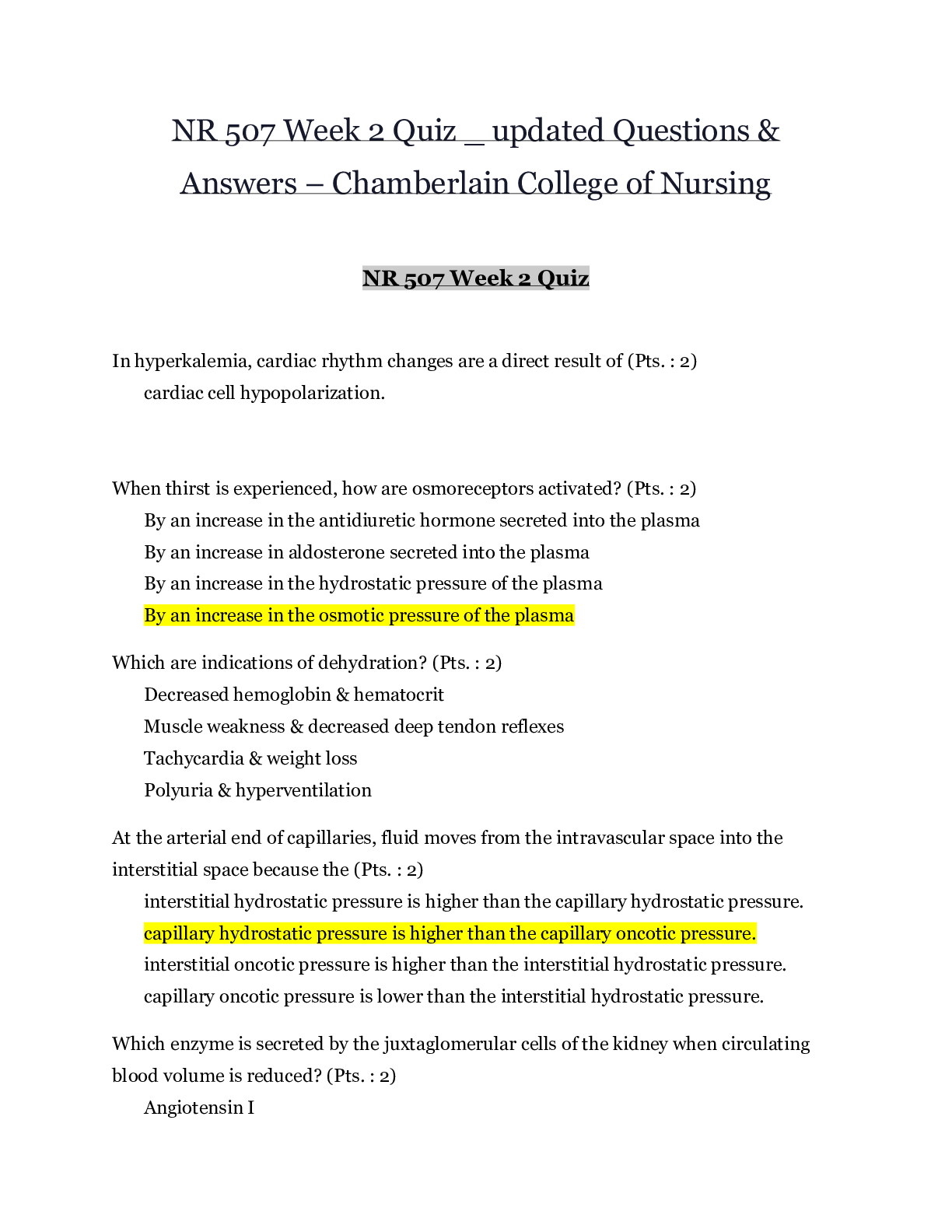
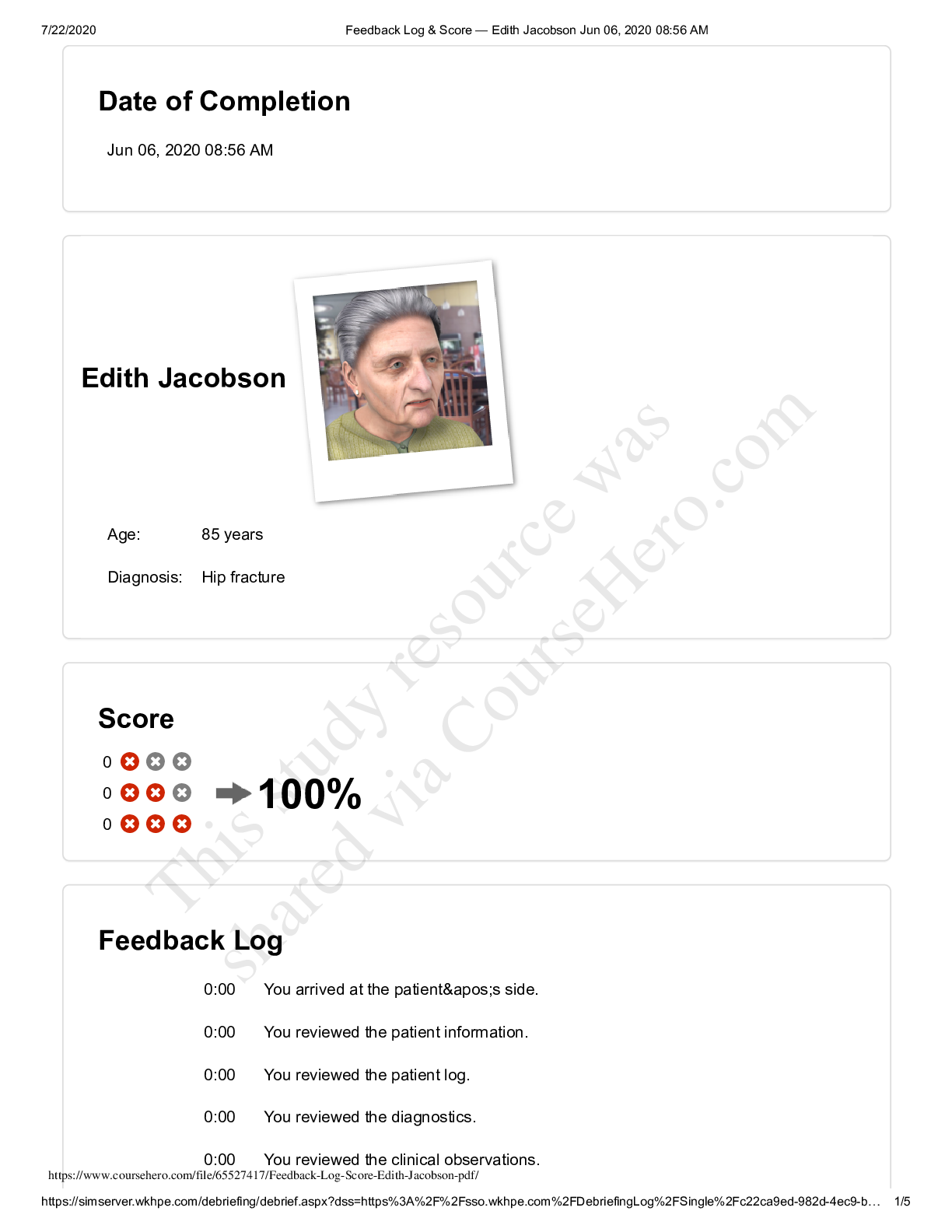
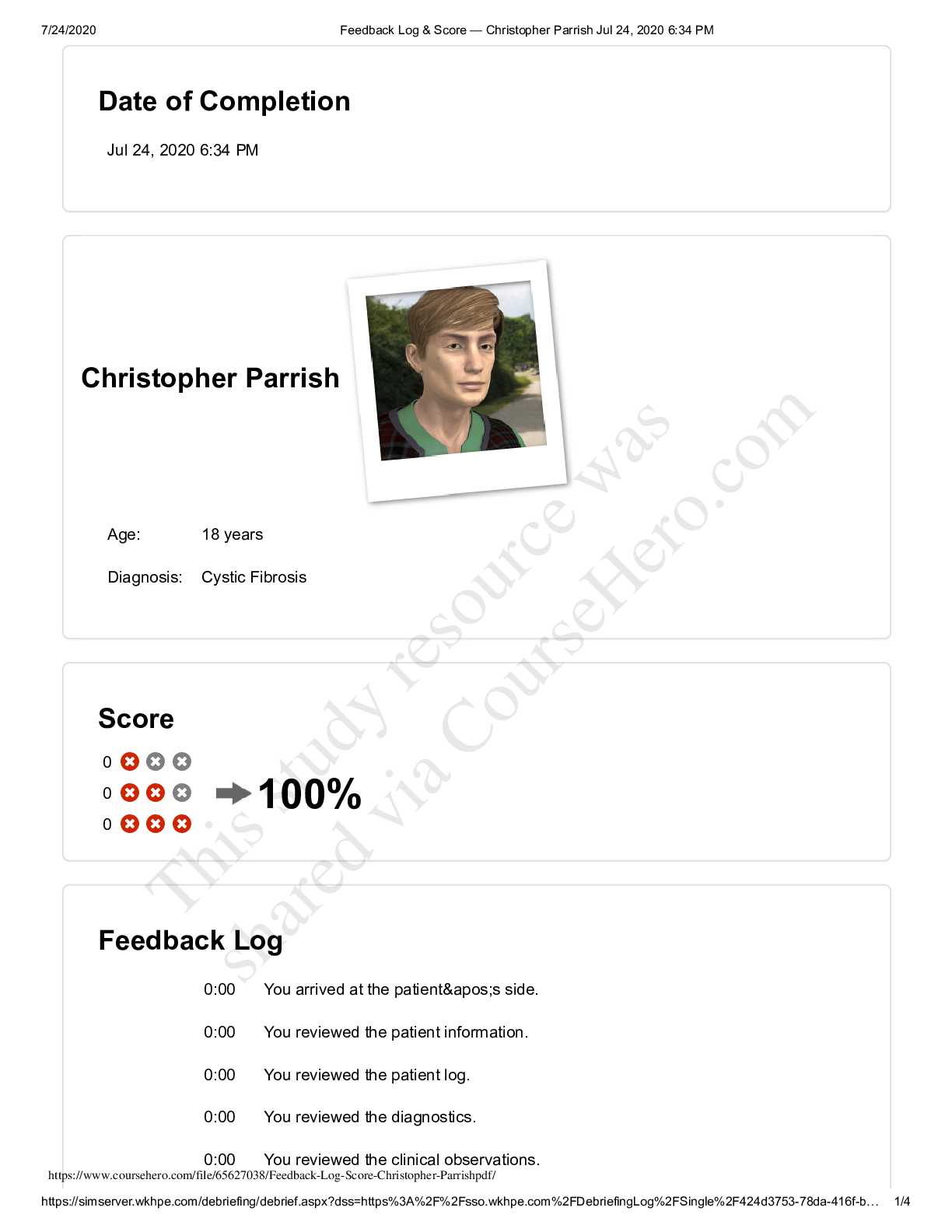
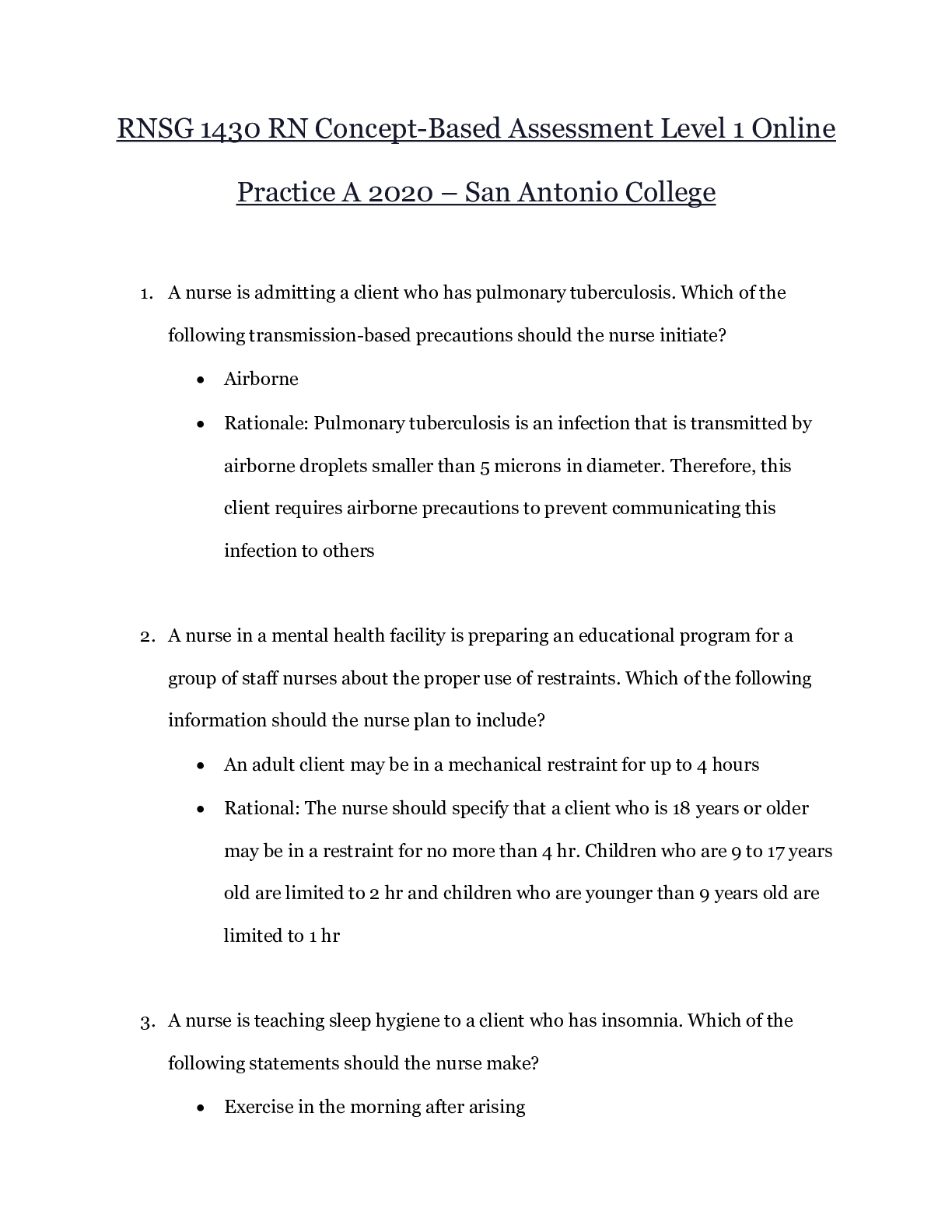


 – CHAMBERLAIN COLLEGE OF NURSING.png)
